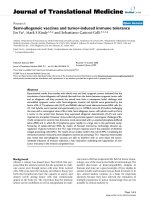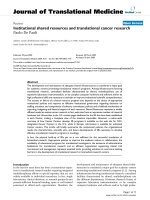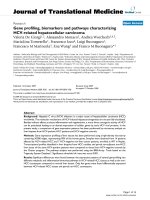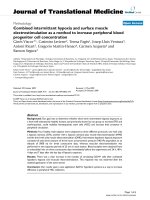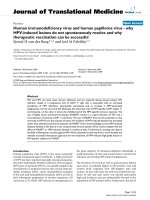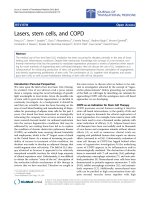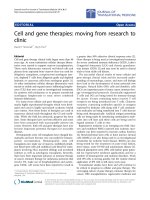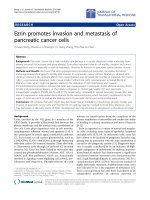báo cáo hóa học: " Peripheral leukocyte counts and outcomes after intracerebral hemorrhage" doc
Bạn đang xem bản rút gọn của tài liệu. Xem và tải ngay bản đầy đủ của tài liệu tại đây (204.48 KB, 4 trang )
SHOR T REPOR T Open Access
Peripheral leukocyte counts and outcomes after
intracerebral hemorrhage
Shruti Agnihotri
1
, Alexandra Czap
1
, Ilene Staff
2
, Gil Fortunato
2
and Louise D McCullough
1*
Abstract
Background: Intracerebral hemorrhage (ICH) is a devastating disease that carries a 30 day mortality of
approximately 45%. Only 20% of survivors return to independent function at 6 months. The role of inflammation in
the pathophysiology of ICH is increasingly recognized. Several clinical studies have demonstrated an association
between inflammatory markers and outcomes after ICH; however the relationship between serum biomarkers and
functional outcomes amongst survivors has not been previously evaluated. Activation of the inflammatory response
as measured by change in peripheral leukocyte count was examined and assessment of mortality and functional
outcomes after ICH was determined.
Findings: Patients with spontaneous ICH admitted to a tertiary care center between January 2005 and April 2010
were included. The change in leukocyte count was measured as the difference between the maximum leukocyte
count in the first 72 hours and the leukocyte count on admission. Mortality was the primary outcome. Secondary
outcomes were mortality at 1 year, discharge disposition and the modified Barthel index (MBI) at 3 months
compared to pre-admission MBI. 423 cases were included. The in-hospital mortality was 30.4%. The change in
leukocyte count predicted worse discharge disposition (OR = 1.258, p = 0.009). The change in leukocyte count was
also significantly correlated with a decline in the MBI at 3 months. These relationships remained even after removal
of all patients with evidence of infection.
Conclusions: Greater changes in leukocyte count over the first 72 hours after admission predicted both worse
short term and long term functional outcomes after ICH.
Keywords: Intracerebral Hemorrhage, Outcomes, Inflammation, Leukocyte Count
Findings
Cerebrovascular disease is the leading cause of morbidity
and mortality in the United States. Intracerebral hemor-
rhage (ICH ) is a devastating subty pe of stroke, which has
worse outcomes than ischemic strok e, is increasing in
prevalence, and has a 30 day mortality of 40-50% [1,2].
Only 20% of patients with ICH return to independent
function at 6 months [2,3]. Despite advances in mana ge-
men t, the mortality of ICH has not changed significantly
over time [4]. The role of inflammation in the pathophy-
siology of ICH is now increasingly recognized. In animal
models, a robust inflammatory response is triggered by
the entry of blood into the brain parenchyma [5] with a
subsequent infiltration of peripheral leukocytes,
activation of microglia and release of cytokines [6,7].
Autopsies in both animals [8] and humans [9] with ICH
demonstrate leukocytic infiltration usually wi thin first 3
days and inflammatory changes in the penumbra of the
hemorrhage. Few clinical studies have demonstrated
association between the inflammatory markers and out-
comes of ICH in terms of mortality [10,11]. None of
these studies evaluated functional or long term outcomes.
We evaluated the relationship between activation of
theinflammatoryresponseasmeasuredbychangein
peripheral leukocyte count, and mortality and functional
outcomes after ICH.
This is a retrospective analysis from the existing
stroke database at Hartford Hospital, a tertiary care hos-
pital with a primary stroke center in Hartford, CT, USA.
The study was reviewed and approved by the Hartford
hospital IRB. We included patients with spontaneous
ICH from Jan 2005 to April 2010. We excluded
* Correspondence:
1
Department of Neurology, University of Connecticut, 263 Farmington
Avenue, Farmington, CT, USA
Full list of author information is available at the end of the article
Agnihotri et al. Journal of Neuroinflammation 2011, 8:160
/>JOURNAL OF
NEUROINFLAMMATION
© 2011 Agnihotri et al; licensee BioMed Central Ltd. This is an Open Acc ess article distributed under the terms of the Creative
Commons Attribution License ( w hich permits unrestricted use, distribution , and
reproduction in any medium, provided the origi nal work is properly cited.
subarachnoid hemorrhages, hemorrhages secondary to
trauma, malformations, coagulopathy, and tumors as
well as patients with leukemia. Baseline characteristics
including age, gender, blood pressure, infection within
first 72 hours, NIH on admission and ICH score were
obtained. The maximum leukocyte counts in the first 72
hours as well as on admission were recorded. The differ-
ence between the two values was calculated to obtain
the independent variable of change in leukocyte count,
which was measu red as a continuous variable. The out-
comes were measured as in hospital mortality, 12
month mortality, discharge disposition, and the loss on
MBI points calculated as a difference between a pre
stroke MBI and a MBI at 3 months. Disposition was
dichotomized as discharge to worse vs. same or better
based on the pre-admit residence. The loss of MBI
points was measured as a continuous variable. Data on
infection within first 72 hours including that on admis-
sion was also collected. Patients with clinical signs and
symptoms of infection, i ncluding fever, raised pe ripheral
WBC, worsening sensorium, cough, abdominal pain, or
diarrhea underwent an infectious work up. The initial
work up included urinalysis, chest x-ray, blood cultures,
stool for Clostridium difficile.Ifthesewereabnormal,
appropriate cultures were obtained. Those cultures that
were identified as bacterial colonization, were excluded
from our analysis. Further s ubgroup analysis after
removal of patients with documented infections was also
performed. SPSS was used to perform statistical analyses
including t-test, linear correlation, and logistic regres-
sion. A p value of < 0.05 was considered significant.
There were a total o f 423 cases. The in-hospital mor-
tality was 30.4%. The 1 year mortality was 45.2%. The
change in leukocyte count information was missing in
68 cases. This was mostly due to elderly patients being
made comfort measures only within first 24 hours of
admission. Of, the 255 patients alive at 3 months, the
MBI data for 3 months was missing in 84 cases. Of the
241 patients alive at 12 months, the MBI data for 12
months was missing in 160 cases. The background
demographics and baseline leukocyte information are
listed in table 1. Data on infection show that lung and
urine infections predominate (Table 2). In univariate
analysis (Table 3), the change in leukocyte count was
significantly associated with mortality (r = 1.083, p =
0.039) as well as with worse discharge disposition (r =
1.357, p = < 0.001). The change in leukocyte count also
correlated with the loss of points on MBI at 3 months
compared to a pre-event MBI (r = 0.382, p = < 0.001).
In a multivar iate logistic regression model (Table 3), the
change in leukocyte count was associated with in hospi-
tal mortality as well as 12 month mortality with an odds
ratio of 1.096 but none were statistically significant.
However, it did predict worse disch arge disposition with
an odds ratio of 1.258 (p = 0.009) after adjustment for
various confounders including age, gender, infection,
extraventricular drain (EV D) placement, etiology of
bleed, ICH score and NIH score on admission. The co r-
relation with the change in MBI score at 3 months
remained significant (r = 0.222, p = 0.005) after adjust-
ment for various confounders. The same trend could
not be demonstrated for a MBI change at 12 months
from the event. A subgroup analysis was performed
after excluding all patients with infection within the first
72 hour s. The change in leukocyte count over 72 hours
remained a significant predictor of a worse discharge
disposition (OR = 1.296, p = 0.013)
Our results demonstrate that peripheral activation of
inflammation predicts outcomes after ICH. Prior clinical
studies have examined temperature, admission leukocyte
count and C-reactive protein as measures of inflamma-
tion and have demonstrated their association with ICH
volume and mortality [10,11]. Previous studies have
documented that higher peripheral leukocyte counts are
associated with early neurologic deterioration but were
not independently associated with functional outcomes
as measured by modified rankin scale at 30 days [12].
One recent study found that although a higher white
blood cell count was associated with increased mortality
in ICH patients, but this did not increase the risk of
death independently of other indicators of ICH severity
Table 1 Demographics and Leukocyte data
Frequency
(Percentage)
Gender
Male 204 (48.2)
Female 218 (51.5)
Age 71.67 (13.8)*
ICH volume (in cubic centimeters) 33.90 (41.8)*
NIH on admission 9.96 (7.8)*
Etiology
Hypertension 315 (74.5)
Amyloid 108 (25.5)
Extraventricular drain 31 (7.3)
First leukocyte count 9.79 (4.17)*
Maximum leukocyte count in the first 72 hours 11.97 (4.56)*
Change in leukocyte count from admission to
72 hours
1.95 (2.71)*
* mean of frequencies (standard deviation)
Table 2 Infection data
Frequency (Percentage)
Infection within 72 hours 55 (13)
Lung infection within 72 hours 31 (7.3)
Urine infection within 72 hours 27 (6.4)
Agnihotri et al. Journal of Neuroinflammation 2011, 8:160
/>Page 2 of 4
[10]. In contrast to our work, no association was seen
between median leukocyte count and functional out-
come at 30 days [10]. This may be due to the two-fold
larger sample size and the use of change in WBC over
72 hours rather than use of the median WBC count in
this study. The robustness of our data is evident in the
fact that in the subgroup analysis where infections are
excluded, the association between change in leukocyte
count and the discharge disposition remains significant.
Peripheral leukocytes are a marker of the response of
the immune system and reflect the activation of the
inflammatory cascade following a spontaneous ICH [13].
This is an easily and widely available biomarker. The
change in the leukocyte count over 72 hours may better
reflect the amount of inflammatory response mounted
in response to the ICH compared to a si ngle value. The
use of this variable is advantageous as it reduces the
impact of premorbid conditions that affect the leukocyte
count, and may more accurately reflect the amount of
neuroinflammation as it remained predictive even when
adjusted for infections on admission as well as those
that developed within 72 hours of presentation.
In our study, the peripheral leukocyte count indepen-
dently predicts poor functional outcomes in terms of
discharge disposition and the loss of points on the MBI
at 3 months. This suggests that activation of peripheral
immune system may enhance injury a fter ICH, consis-
tent with emerging experimental work [13]. We could
not establish an association with mortality and it is
most likely due to loss o f leukocyte count data on
patients who were made hospice early on in the care.
Similarly, we could not establish a trend for MBI at 12
months largely due to missing information which is a
limitation in this study. However, the change in leuko-
cyte count was predictive of outcome at 3 months, one
of the longest outcome assessments correlated with a
biomarker to date in ICH patients.
There are several limitations of this study which
include the retrospective design, single center population
and missing data on certain variables, especially at 12
months,largelyduetothehigh mortality from this dis-
ease. However, this is one of the largest samples to date,
and clearly demonstrated the association between the
peripheral immune response and poor functional out-
comes after ICH independent of in fection or hemorrhage
size. Treatments for ICH have focused on blood pressure
management and reducing ICH volume [14]. None of
these treatments have made a significant impact on
patient outcome. Mortality and morbidity have not chan-
ged in several decades, despite improvements in ICU
car e. This study provides furthe r evidence for the poten-
tial of targeting neuroinflammation as a treatment mod-
ality to improve outcomes amongst ICH survivors.
Acknowledgements
To SA (Department of Neurology Resident Research Fund), AC (Hartford
Hospital Small Grant Program).
Author details
1
Department of Neurology, University of Connecticut, 263 Farmington
Avenue, Farmington, CT, USA.
2
Department of Research, Hartford Hospital,
80 Seymour Street, Hartford, CT, USA.
Authors’ contributions
LM: Conceived the study, revised the manuscript. SA: Participated in study
design and co-ordination, drafted the manuscript. AC: Performed data-
collection and chart reviews. IS: Performed statistical analysis. GF: Performed
data extraction and database maintenance. All authors have read and
approved the final manuscript.
Competing interests
The authors declare that they have no competing interests.
Received: 11 July 2011 Accepted: 16 November 2011
Published: 16 November 2011
References
1. Roger VL, Go AS, Lloyd-Jones DM, Adams RJ: Heart disease and stroke
statistics - 2011 update: a report from the American Heart Association.
Circulation 2011, 123(4):e18-e209.
2. Van Asch CJ, Luitse MJ, Rinkel GJ: Incidence, case fatality, and functional
outcome of intracerebral haemorrhage over time, according to age, sex,
and ethnic origin: a systematic review and meta-analysis. Lancet Neurol
2010, 9(2):167-176.
3. Bamford J, Sandercock P, Dennis M, Burn J, Warlow C: A prospective study
of acute cerebrovascular disease in the community: the Oxfordshire
Community Stroke Project–1981-86. 2. Incidence, case fatality rates and
overall outcome at one year of cerebral infarction, primary intracerebral
and subarachnoid haemorrhage. J Neurol Neurosurg Psychiatry 1990,
53(1):16-22.
4. Flaherty ML, Haverbusch M, Sekar P: Long-term mortality after
intracerebral hemorrhage. Neurology 2006, 66:1182-1186.
5. Loftspring MC, Hansen C, Clark JF: A novel brain injury mechanism after
intracerebral hemorrhage: the interaction between heme products and
the immune system. Med Hypotheses 2010, 74(1):63-66.
Table 3 Change in Leukocyte counts: admission to maximum in 72 hours
Univariate Multivariate
OUTCOME N Correlation p value N OR/Correlation p value
Inhospital Mortality 405 1.083 0.039 355 1.096 0.134
Discharge Disposition 404 1.357 0.000 354 1. 258 0.009
1 year mortality 406 1.074 0.055 1.096 0.088
MBI change @ 3 months 179 0.382 0.000 171 0.222 0.005
MBI change @ 12 months 83 0.107 0.334 81 -0.118 0.322
Agnihotri et al. Journal of Neuroinflammation 2011, 8:160
/>Page 3 of 4
6. Xi G, Keep RF, Hoff JT: Mechanisms of brain injury after intracerebral
hemorrhage. Lancet Neurol 2006, 5(1):53-63.
7. Wang J, Doré S: Inflammation after intracerebral hemorrhage. J Cereb
Blood Flow Metab 2007, 27(5):894-908.
8. Gong C, Hoff JT, Keep RF: Acute inflammatory reaction following
experimental intracerebral hemorrhage in rat. Brain Res 2000,
871(1):57-65.
9. Mackenzie JM, Clayton JA: Early cellular events in the penumbra of
human spontaneous intracerebral hemorrhage. J Stroke Cerebrovasc Dis
1999, 8(1):1-8.
10. Di Napoli M, Godoy DA, Campi V, del Valle M: C-reactive protein level
measurement improves mortality prediction when added to the
spontaneous intracerebral hemorrhage score. Stroke 2011,
42(5):1230-1236.
11. Suzuki S, Kelley RE, Dandapani BK: Acute leukocyte and temperature
response in hypertensive intracerebral hemorrhage. Stroke 1995,
26(6):1020-1023.
12. Liera R, Davalos A, Silva Y, Gil-Peralta A, Tejada J, Garcia M, Castillo J: Early
neurologic deterioration in intracerebral hemorrhage: Predictors and
associated factors. Neurology 2004, 63:461-467.
13. Aronowski J, Zhao X: Molecular pathophysiology of cerebral hemorrhage:
secondary brain injury. Stroke 2011, 42:1781-6.
14. Qureshi AI, Mendelow AD, Hanley DF: Intracerebral haemorrhage. Lancet
2009, 373:1632-1644.
doi:10.1186/1742-2094-8-160
Cite this article as: Agnihotri et al.: Peripheral leukocyte counts and
outcomes after intracerebral hemorrhage. Journal of Neuroinflammation
2011 8:160.
Submit your next manuscript to BioMed Central
and take full advantage of:
• Convenient online submission
• Thorough peer review
• No space constraints or color figure charges
• Immediate publication on acceptance
• Inclusion in PubMed, CAS, Scopus and Google Scholar
• Research which is freely available for redistribution
Submit your manuscript at
www.biomedcentral.com/submit
Agnihotri et al. Journal of Neuroinflammation 2011, 8:160
/>Page 4 of 4
